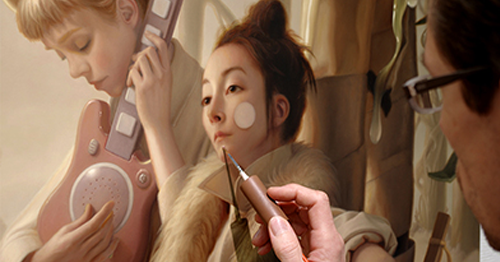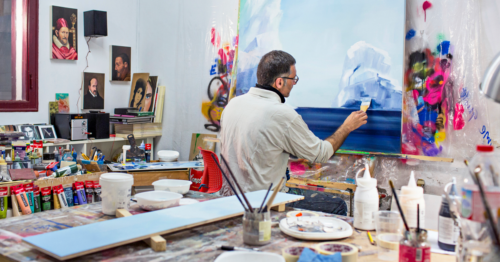If you have ever wondered how artists like DaVinci or Rembrandt could have created such breathtaking works of art, then this course is for you. Even if you are a beginner, you can learn the steps and techniques that the great masters used to paint timeless masterpieces. Climbing the tallest mountain is possible if you take it one step at a time.
In this five session introductory workshop, Steve Chmilar will demystify the atelier oil painting method by breaking it down in the easily manageable steps. All the materials you will need can be found at any art store. This course will be taught in an odour free environment without the use of any toxic mediums such as thinner or turpentine. Over the five sessions, we will paint a carefully selected copy of a simple still life or landscape that is easy enough for anyone to do, yet beautiful enough to proudly hang for display.
Encouraging note: It is commonly thought that oil painting is more difficult than acrylic. I will show you why it is actually easier in many ways. The word ‘classical’ may sound advanced but this course is designed to give painters at any skill level a sound understanding of fundamental techniques that can be used for any style.
Steve Chmilar is one of Canada’s foremost New Contemporary painters. Since his debut show at the Art Gallery of Greater Victoria in 2011, he has painted full-time by selling his work internationally to private collectors. In 2012, he won best in show at the Toronto Outdoor Art Exhibit (Canada’s largest juried exhibition) and Prix De La Meilleure Oeuvre (Prize for Best Work) Mtl en Arts in Montreal. Please view Steve’s bio in the instructors tab for more information.
Please note: We maintain small class sizes to ensure a personalized and welcoming environment. Each student will have their own table to create on in a large, well lit 900 sq ft studio with lots natural light studio.
Steve Chmilar is one of Canada’s foremost New Contemporary painters. Since his debut show at the Art Gallery of Greater Victoria in 2011, he has painted full-time by selling his work internationally to private collectors. In 2012, he won best in show at the Toronto Outdoor Art Exhibit (Canada’s largest juried exhibition) and Prix De La Meilleure Oeuvre (Prize for Best Work) Mtl en Arts in Montreal. He has been featured on HiFructose,com and John Dalton’s Gently Does it podcast. Recently, he placed as a top finalist out of thousands of international entries in two of the internets largest art competitions: the 2nd annual Jonathan LeVine projects Delusional Art Competition and the Beautiful Bizarre Magazines Art Prize.
Steve’s teaching style is patient and encouraging. “I strive to make a learning environment as relaxed as possible while giving out a lot of information. A light-hearted, low-pressure space that is full of positive energy is the best place to absorb new information and experiment”.
Small painting panel or canvas:
Primed. 11″x14″ is the ideal size. 8”x11” or 8”x10” can work as well.
Brushes:
-Flat or angle flat: small, medium to large or 8 to 20 or 1/4” to 1” (8mm to 24mm) -Filbert: small to medium, 1 to 4 or 1/4” to 1/2” (8mm to 12mm)
-Round: very small to medium, 0 to 6, most importantly sizes 2 to 4.
Oil Paints:
(small 37ml tubes are plenty – any brand including student grade can work)
For the First Class: Raw umber or Burnt umber are must haves
For the following Classes:
-Titanium White. Fast drying white is nice for the second class but not necessary.
-Raw Umber,
-Burnt Umber,
-Prussian Blue or Ultramarine Blue
-Any Black such as Mars or Ivory
– One bright primary yellow such as Lemon Yellow, Hansa Yellow light, or Cadmium Yellow light.
– One earth yellow such as Yellow Ochre, Transparent Earth Yellow or Raw Sienna.
– One bright primary red such as Cadmium Red Light, Napthol Red, Pyrol or Azo red.
– Alizarin Crimson.
The paints listed above are very likely to be used in our class. Feel free to bring any other oil paints that you already have.
Additional Items:
– Refined Linseed Oil. Any small quantity of any brand will do. – Mixing surface or palette of any kind.
– Palette Knife: a Trowel shaped palette knife is ideal. Not flat. A trowel knife should have a triangular or tear drop shape and have a blade surface that is lower than the handle.
– Rags or cloths. One or two is plenty.
Supplied by instructor during the first class will be as follows:
Reference Images
Notes on technical information and theory.




